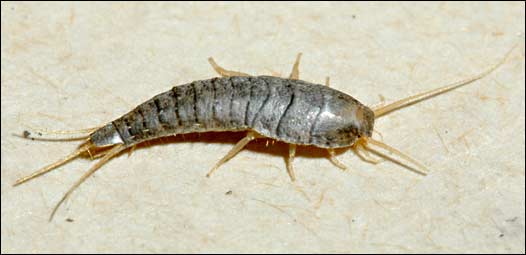Form and Function
Silverfish form is very unique when it comes to insects. The dorsal side of the body, which can reach 3/4 inch in length, is comprised of silver colored scales. Silverfish are born looking very similar to their adult forms except for one key difference, color. Like all Anthropods silverfish go through exdysis, the process of molting, and it is through this process which they gain their silvery appearance. The amount they molt is also unusually high for a member of their class, with some silverfish molting close to 70 times during their 2 to 8 year lifespan (Cox,2012). These silver scales aren't just for looks, they serve an important defensive mechanism. The scales easily fall off, so when a predator latches on, the silverfish can get away leaving only a scale for the attacker (University of Wisconsin - Milwaukee).
The silverfish also has three long bristles
coming from its anterior end and two from its posterior end
(Cox,2012). These bristles allow the silverfish to avoid
predators by sensing the movement of air around them, giving them a
faster reaction time to an approaching predator
(University
of Arkansas, 2005). These are especially essential
because the silverfish has poor eye sight(University
of Wisconsin - Milwaukee).The silverfish is built to get away
from predators and hide. It is capable of accelerating rapidly to
get away predators and is dorsoventrally flat which allows it to
sneak into small cracks and holes in order to hide
(Cox,2012)
(Sturm 2009). It is not able to fly because it does not
have wings and it comes from a lineage that never possessed the
capability of flight. Flight is not a necessity for this Anthropod
because of its speed, shape and it's rem ovable scales
(University of Wisconsin - Milwaukee).
ovable scales
(University of Wisconsin - Milwaukee).
As for their form that helps them feed, Silverfish have maxillary palps to consume food with (Sturm, 2009). One unique thing about the Silverfish, is that they have cellulase in their digestive system, which is a enzyme that helps them digest cellulose, one of their main food sources (Lasker and Giese, 1956).
